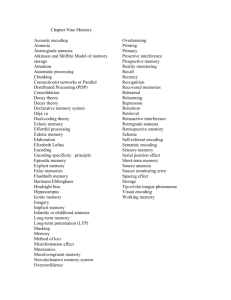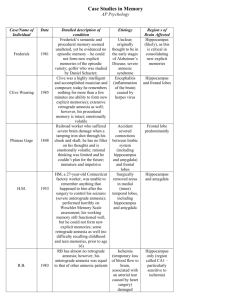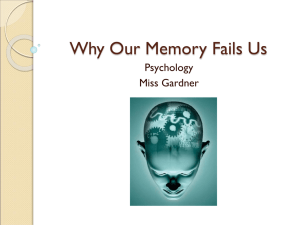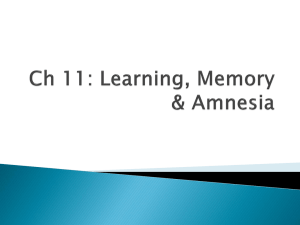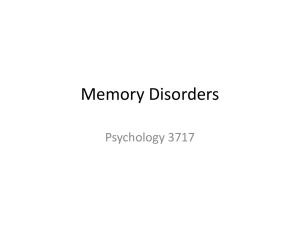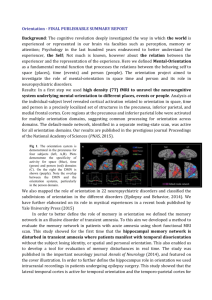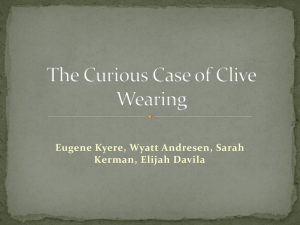Slides
advertisement
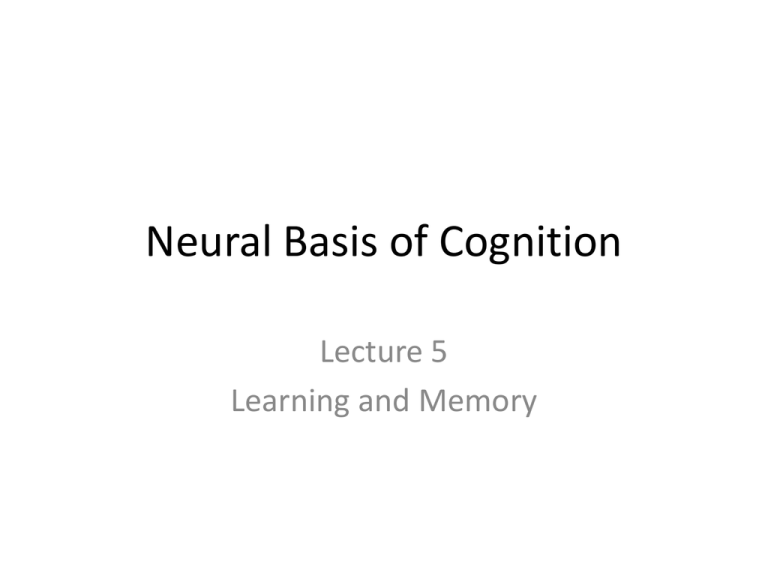
Neural Basis of Cognition Lecture 5 Learning and Memory The Famous Patient, H.M. • Severe epilepsy can be debilitating and even lead to death. In extreme cases, surgery is used to treat epilepsy • In 1953, a patient called H.M. (to preserve anonymity) with severe epilepsy was treated surgically via removal of portions of his left and right medial temporal lobes – Removed: two thirds of his hippocampus, parahippocampal gyrus, and amygdala – Damaged/Atrophied: the remainder of his hippocampus, entorhinal cortex, some of his anterolateral temporal cortex H.M. • What happened? – His epilepsy was successful brought under control. – He developed severe memory deficits - amnesia. • Why is his case so famous? – His memory abilities were extensively studied prior to the operation, allowing extensive postoperative analysis. – Today’s imaging techniques did not exist; the fact that damage was done during surgery meant that it was known exactly what parts of his brain were damaged. H.M. • What abilities have been destroyed? – Creation of new short term memories – he cannot recall recent weather, the current date, where he currently lives, or even a conversation with someone if there is an interruption that lasts a few minutes – Learning of new information – He would misidentify current pictures of himself as pictures of his father – He had no idea of his fame H.M. • What abilities were not destroyed? – Linguistic ability, recall of memories formed before the operation, ability to reason - almost all abilities he had before the operation aside from those listed on the previous slide – Learning of new skills – Working memory (until distracted) H.M. • The extensive study of H.M. taught us much about what we now know about learning and memory in humans. • He passed away in 2008, still unaware of his fame. Memory • What is memory? – Memory is the storing of information related to day-to-day experiences for later retrieval. • Are there different types of memory? – Yes. • Is memory stored in a single part of the brain? – No. How can amnesia occur? • Damage to the medial temporal lobe – Herpes simplex encephalitis, blockage of blood supply, hypoxic ischemia, trauma, Alzheimer’s disease • Damage to the midline diencephalic region – Korsakoff’s diease (due to chronic alcohol abuse), blockage of blood supply, third ventricle tumors Is amnesia always permanent? • No. – Closed head injury (such as in a motorcycle accident) can cause amnesia that almost completely disappears – Electroconvulsive therapy (memory recovers over weeks to months) – Seizures can temporarily induce amnesia that heals completely. Memory impairment • Anterograde amnesia: Impairment in forming new memories. – Almost always associated with some retrograde amnesia. • Retrograde amnesia: Impairment in memory for information acquired prior to amnesia-inducing event – In closed head injury, retrograde amnesia extends back less than a week before the injury in 80% of patients, but can extend to years. – H.M.’s retrograde amnesia extended 11 years; unclear how much of this was due to the seizure disorder, which began 11 years before surgery, and how much was due to the surgery – Retrograde amnesia that extends back decades is often seen in progressive disorders such as Korsakoff’s, Alzheimer’s, Parkinson’s, or Huntington’s – Temporal gradient (Ribot’s Law): generally, more recent memories are more severely affected, e.g. identifying Ronal Reagan – “Flat” Gradients have been observed Amnesia • Modality general, including in H.M.’s case • Therefore, amnesia is a deficit in memory functions rather than perceptual, linguistic, or other cognitive processes • Unilateral hippocampal damage CAN be modality-specific – Left hemisphere damage can lead to selective impairment for verbal material, right hemisphere damage for nonverbal material Working Memory • Digit span task: repeating back, in order, a string of digits – H.M.: Normal performance (7 +/- 2 digits) • Extended digit span task: once a patient’s digit span is known, the same string is iteratively lengthened by one digit until a limit is reached – Normal performance: 20+ digits – H.M.’s performance: no longer than the digit span task Retained abilities • Skill learning – H.M. did exhibit some forms of learning, though he was unaware of having done so – Mirror tracing task: tracing the outline of a figure by looking at it in a mirror • Across sessions, H.M. began to perform this task more accurately and more quickly – Rotary pursuit: tracking a circularly moving target • With practice, amnesiacs become more adept Retained abilities • These are motor skills that are repeated over and over; are amnesiacs learning the specific instance of those tasks (such as drawing a particular figure) or the skill in general? • Mirror-reading task: mirror images of word triplets shown – Amnesiacs show the same improvement in this task – even with new words – that non-amnesiacs do, even if the patients cannot recall practicing Retained abilities • Repetition priming: performance is enhanced as a result of previous exposure to an item – Gollin incomplete pictures task: patients are shown very degraded and incomplete line drawings of objects and are asked to name them • The procedure is repeated with increasingly incomplete drawings • Amnesiacs showed improvement on this task Retained abilities • Word-stem completion task – Patient is given a list of words to study – After a delay, memory is tested in two ways using three-word stems of these words: • Patient is asked to recall the word from the study list that began with the given three-letter stem – Amnesiacs perform poorly • Patient is asked to give “the first word that comes to mind” when given a three-letter stem – Amnesiacs performed at normal levels Memory loss patterns • Explicit memory: – Conscious recollection of some prior event • Implicit memory: – Subconscious recollection of information about some prior event – Does not depend on consciously remembering that event – “memory without awareness” • Explicit but not implicit memory can be impaired or destroyed due to hippocampal damage Eye-movement monitoring • Amnesiac is shown an image with three points of interest – Eye movements indicate he looks at each of the three points of interest • After a delay, the amnesiac is shown the same image with one point of interest removed – There are about as many eye movements to the nowabsent third point of interest as there are to the other two points of interest, but if the patient is asked, he will not remember that there was a third point of interest • This is a demonstration of implicit versus explicit memory impairment due to hippocampal damage Neuroimaging evidence • PET and fMRI provide converging evidence that the hippocampal system is associated with relational memory • Higher activation when given a task that requires memory of relations among items The role of the hippocampal area • After damage to the hippocampal area, amnesia can develop • Therefore, the hippocampal area is vital for the formation of new memory • After damage, previously formed memories can still be recalled • Therefore, the hippocampus neither stores memories nor is mandatory for memory recall Where is memory stored? • Imaging studies and cell recording studies show that declarative memory is distributed by modality, in the regions which initially process sensory input – Visual information is stored in the visual system, auditory information is stored in the auditory system, and so on • Similar studies show that procedural memory is stored in the parts of the brain involved in carrying out the related action – For example, motor skills are learned and “stored” in the motor cortex Integration of memory systems • Unclear. The memory system • Encoding: – Memories must be created and stored • Consolidation: – Memories may be “strengthened” • Retrieval: – Memories must be retrieved for later use Hippocampus • Encoding: – Activation during encoding of faces, words, scenes, objects; degree of activity is proportional to degree of memorization – fMRI studies show that the amount of activity at the time an item is first seen and encoded predicts how well that item is remembered later on – Subsequent memory effect: subsequently remembered items are associated with greater activation at encoding time than items not subsequently remembered Hippocampus • Consolidation: – Unclear mechanism – Theory: reactivation of already stored memories during the time after learning plays a crucial role in consolidation – There is some evidence tying such reactivation to activity in the hippocampus during sleep subsequent to a learning event Hippocampus • Retrieval: – Hippocampal system activation occurs during retrieval of memory – The purpose of this activation has not been determined Next Lecture • Other areas involved in encoding, consolidation, retrieval • Mechanism of the forming of memories (learning) • Computational and theoretical modeling of learning
